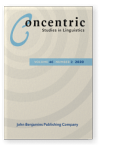Vol. 46:2 (2020) ► pp.125–147
Sensorimotor adaptation and aftereffect to frequency-altered feedback in Mandarin-speaking vocalists and non-vocalists
This research examined sensorimotor adaptation and aftereffect in trained vocalists and non-vocalists whose native language is Mandarin. The adaptive frequency-altered feedback paradigm involving a baseline of normal auditory feedback, a training phase of incrementally or decrementally changed feedback, and a test phase of normal auditory feedback was administered. The participants were asked to produce the sustained vowel /a/, Mandarin /ma1/ (“mother”), and Mandarin /ma2/ (“hemp”). The results show that the vocalists compensated less than the non-vocalists, suggesting that the vocalists’ audio-motor representations for pitch could be more entrenched than the non-vocalists’. All the participants displayed sensorimotor adaptation, indicating that online recalibration is an innate and automatic process. The presence of the aftereffect, however, depended on the stimulus type and vocal training experience. It appeared in all speakers’ responses to downward shift of /ma1/ and /ma2/, but only in the non-vocalists’ responses to /a/.
Article outline
- 1.Introduction
- 1.1Compensation: The effects of vocal experience and language experience
- 1.2Sensorimotor adaptation and aftereffect
- 1.2.1The effect of vocal training experience
- 1.2.2Tone production
- 1.2.3The effect of tonal language experience
- 1.3Motivation and hypotheses
- 2.Methods
- 2.1Participants
- 2.2Materials and procedures
- 2.3Data analysis
- 3.Results
- 3.1Compensation and sensorimotor adaptation
- 3.1.1The compensation and adaptation in the productions of AH and MA1
- 3.1.2The compensation and adaptation in the production of MA2
- 3.1.3Comparison across the three tasks (AH, MA1, and MA2) regarding compensation and adaptation
- 3.2Aftereffect
- 3.2.1The aftereffect in the productions of AH and MA1
- 3.2.2The aftereffect in the production of MA2
- 3.2.3Comparison across the three tasks (AH, MA1, and MA2) in the aftereffect
- 3.1Compensation and sensorimotor adaptation
- 4.Discussion
- 4.1Sensorimotor adaptation
- 4.2Compensation
- 4.3Aftereffect
- 5.Conclusion
- Acknowledgements
- Note
-
References
For any use beyond this license, please contact the publisher at [email protected].
